Firefighters Blue Tunic
CATEGORY: Version
SKU: 74.GOR.02.01.001.000
Estimated market value:
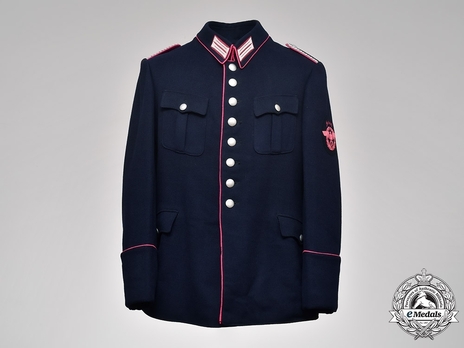
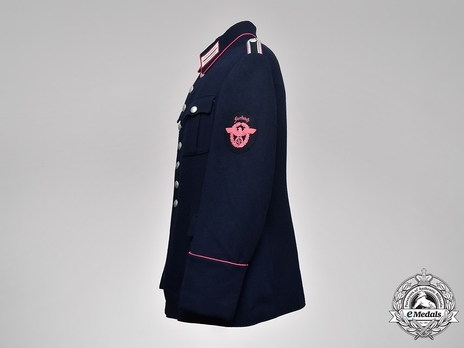
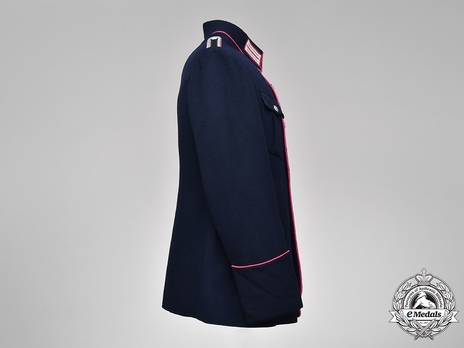
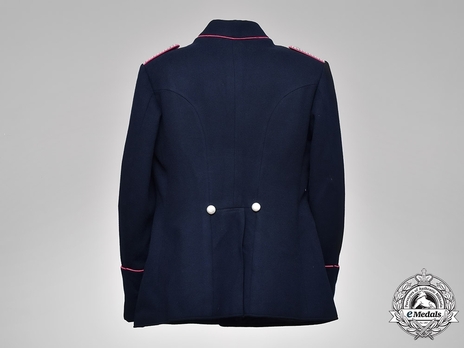
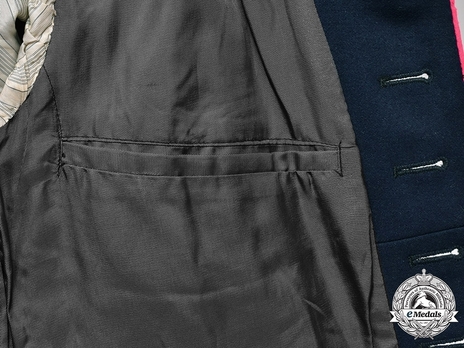
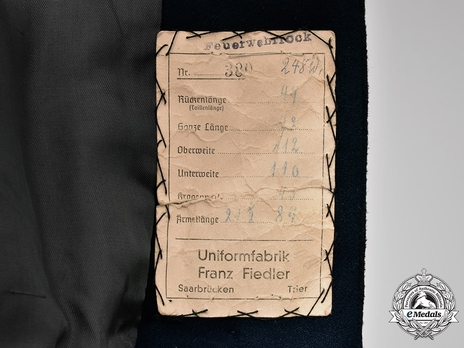
Estimated market value:
This is an extremely well-preserved Feuerschutzpolizei Wachtmeister uniform. The tunic is constructed of a fine quality dark blue wool with a dark-grey rayon-blended interior lining. The breasts of the tunic are closed with eight reinforced buttonholes meeting an equal number of pebbled, silvered zink buttons, five of which are stamped with “RZM M5/314” indicating the maker Paul Brüder, Tyssa b. Bodenbach, and three of which are stamped with “Extra Fein”. The front exterior contains four pockets, all with reinforced button holes and equal number of pebbled buttons, all stamped on the reverse with “Brüder Paul”. The collar, constructed of dark-blue wool, is neatly lined with carmine-coloured piping that continues down the length of the breast flaps. The right interior collar has two magnetic metal hooks meeting an equal number of magnetic metal eyelets on the left allowing the collar to sit flush with the neck. The collar is flanked on each side by tabs composed of carmine-coloured wool base bearing machine-embroidered twisted silver aluminum bullion wire columns, measuring 30 mm (w) x 64 mm (h). Shoulder boards rest on each shoulder, constructed of two rows of brown braided cord flanked by two rows of fine aluminum wire interlaced with black threading, all wrapped in a U-shape chevron formation, finished with reinforced button holes over pebbled zink buttons on a carmine-coloured wool backer indicating a Wachtmeister of the Feuerschutzpolizei, measuring 35 mm (w) x 100 mm (h). The left upper arm bears a sleeve insignia in the form of a police-style German national eagle clutching a wreathed mobile swastika in machine-embroidered, carmine-coloured thread, within a larger oval wreath, all sewn onto a dark blue backing, measuring 85 mm (w) x 100 mm (h). Both cuffs are turned up approximately 135 mm, held up by two pieces of stitching and outlined in carmine-coloured piping. Striped off-white rayon-blended material lines the interior of the sleeves. The interior of the tunic contains a pocket on the upper left breast and a manufacturer's label on the right clearly reading “Uniformfabrik Franz Fiedler” with tailor’s measurements. The collar measures approximately 490 mm at the shoulders, 610 mm in the arms, with an overall length of 780 mm.
Before the NSDAP’s rise to power in 1933, firefighters and their regulations were overseen by the individual German states. Fire services were more or less run by the communities as they saw fit. Larger towns and cities featured professional fire services (Berufsfeuerwehr), while rural areas featured volunteer fire services (Freiwillige Feuerwehr).
Under Third Reich rule, fire services were to be unified on a national level and therefore placed under the control of the German Police. National socialist doctrine was infused and the fire services militarised in preparation for war and the anticipated bombing of German cities.
Between 1933 and 1938, the professional fire service was referred to as “Feuerlöschpolizei” (fire extinguishing police), while between 1938 and 1945, they were referred to as “Feuerschutzpolizei” (fire protection police) as a subdivision of the German Police.
Volunteer firefighters were classified as part of the Hilfspolizei (police auxiliary forces).
Firefighter uniforms had generally been made of dark blue material, predominantly in Prussia. This colour was still used during the 1930s, but then changed in 1939 when members of the professional fire service received a green uniform similar to that of the German Police. The uniform garments featured carmine piping and initially black, later dark brown (as of September 1942) collars, cuffs, and cap bands as identifiers. However, volunteer firefighters kept wearing dark blue uniforms with carmine piping until the end of the war.
The blue tunic was worn until November of 1938 by professional fire service members and then replaced by the green tunic. However, even after 1938 it was still worn by volunteer firefighters, right up until the end of the war.
The tunic was worn closed at the neck. It was closed at the front by eight smooth silver-coloured buttons. It features two pleated breasts pockets and two unpleated hip pockets. There is carmine piping on the closure of the tunic, the cuffs, and the collar.

Comments
Sign in to comment and reply.


Scroll Top